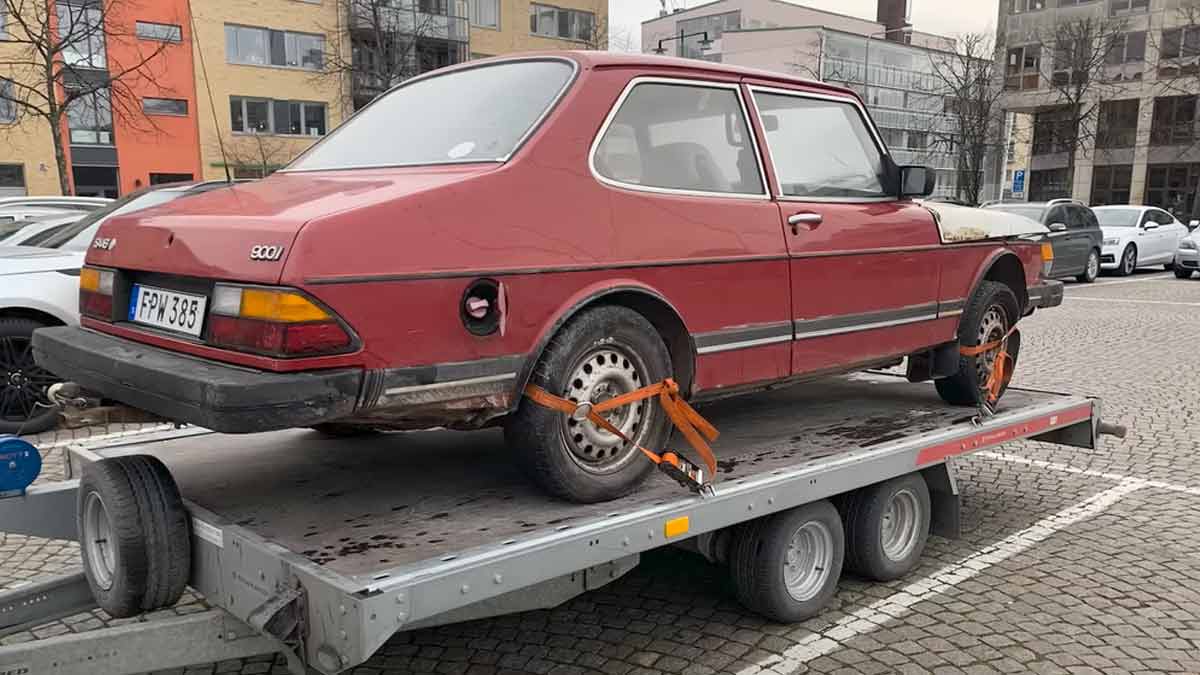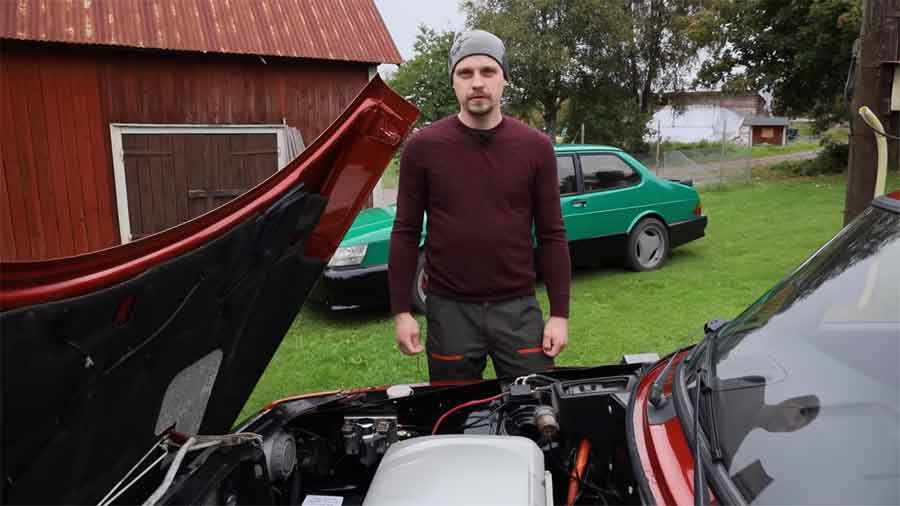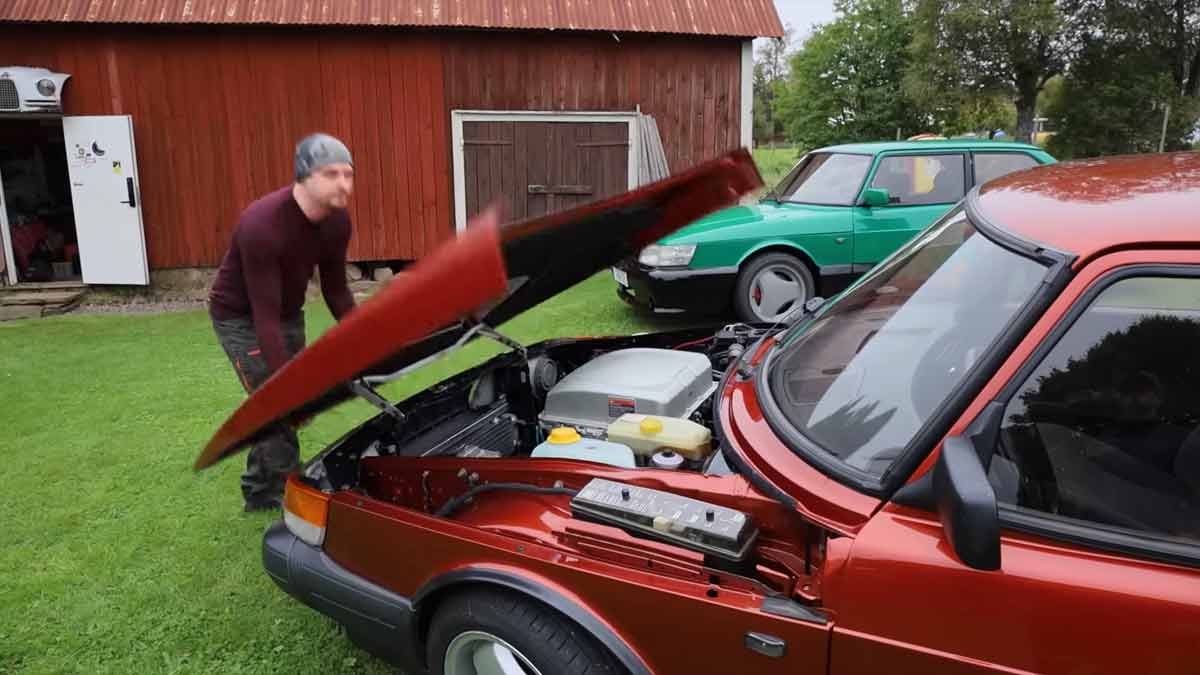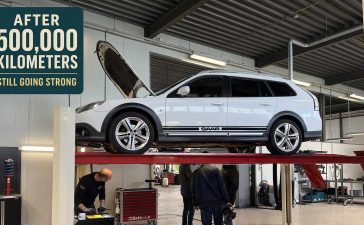In a fascinating endeavor that spanned over two years, Jonas Wallerström (Battery R&D Manager at Husqvarna) embarked on a journey that captured the imagination of automotive enthusiasts and environmentalists alike. He took an old, rusted Saab 900 from 1993 and transformed it into an electric vehicle (EV) using components from a Nissan Leaf. This project not only showcases his passion for Saab but also his commitment to sustainable transportation solutions.
Table of Contents [hide]
- 1 The Genesis of the Project
- 2 A Passion for Cars
- 3 Components from the Nissan Leaf
- 4 Extensive Research and Learning
- 5 A Unique Opportunity in Sweden
- 6 Nerves and Gratification at the Inspection
- 7 The Culmination of a Lifelong Passion
- 8 Watch Jonas Wallerström’s Incredible Electric Saab 900 in Action!
- 9 What Lies Ahead
The Genesis of the Project
Around three years ago, Jonas Wallerström received a gift that would change the course of his life – a weathered Saab 900 from 1993, a model close to his heart. However, there was a significant challenge: the car had been sitting idle for a long time, and its engine was in disrepair. Instead of letting it go to waste, Jonas decided to fulfill a long-held dream of converting a vehicle into an electric one.
Jonas recognized the importance of having someone to share the challenges and triumphs that lay ahead, so he convinced a friend to join him on this remarkable journey.

A Passion for Cars
Jonas, who resides outside Jönköping and works at Husqvarna, is a trained automotive engineer with a deep-rooted passion for cars since his early years. Among all the car brands, Saab has always held a special place in his heart.
He shared, “The fun part is that my parents have no interest in cars; my passion developed on its own. Additionally, I’ve always been a quick learner, even though this project wasn’t particularly theoretical.”
Components from the Nissan Leaf
For Jonas, choosing the right components for the conversion was crucial. He opted for the Nissan Leaf as the donor vehicle, one of the pioneering electric cars in the market. He found the components he needed to merge with the Saab’s classic body.
Jonas explained, “The parts were readily available and affordable. For instance, the drivetrain was cost-effective. The only expensive part was the batteries, which are in high demand now due to their versatility in other applications.”
Extensive Research and Learning
Converting a gas-powered vehicle into an electric one is no small feat. Jonas spent countless hours researching, both online and in various manuals. He delved into electrical schematics and consulted Nissan’s manuals to understand how to connect and integrate the components seamlessly. Engaging with online forums also played a significant role in his learning process.
“It involved a lot of time on the internet. I studied electrical diagrams and looked up Nissan’s various manuals to understand how to connect everything correctly. I also joined and participated in various forums, which provided valuable social interaction and knowledge sharing,” Jonas recounted.
The Treasure Hunt for Spare Parts
A substantial portion of the car’s components came from scrapyards, and most of the vehicle is composed of used parts. Jonas scoured scrapyards across the Nordic region, with a particular emphasis on Norway.

He noted, “Norway is a leader in electric vehicles, so there are plenty of spare parts available there. However, I purchased the batteries in Sweden because transporting them across borders can be challenging.”
A Unique Opportunity in Sweden
One of the unique aspects of Jonas’s project is the ability to modify and build vehicles in Sweden, a luxury not available in many other European countries.
The Swedish Association of Vehicle Builders (Sveriges fordonsbyggares riksorganisation or SFRO) was instrumental in helping Jonas navigate the complex process of modifying and registering his electric Saab. His contact at SFRO happened to be none other than Bosse “Bildoktorn” Andersson, a well-known figure in the automotive world.
“Bosse Bildoktorn was my inspector from SFRO. He went through their checklist with me, ensuring that everything was in order. SFRO also issues certificates and approves modified vehicles,” Jonas said.
Nerves and Gratification at the Inspection
Naturally, Jonas felt some nervousness leading up to the inspection, as any vehicle conversion of this magnitude is bound to bring about anxiety. However, the results exceeded his expectations.
He recalled, “Yes, I was a bit nervous, as one always wonders if everything has been done correctly. But it went very well! I received only positive comments, and the inspectors were almost shocked by the car’s transformation; they even wanted to take pictures.”
The Culmination of a Lifelong Passion
While Jonas had previously undertaken automotive projects, this was his first time converting a conventional car into an electric one. He described it as his most significant project to date, both in terms of scale and personal satisfaction.
“It’s my largest project by far. But I had the opportunity to undertake it at this stage in my life, and it’s been incredibly enjoyable. Moreover, I’d rather talk about my project than myself,” Jonas said.
Watch Jonas Wallerström’s Incredible Electric Saab 900 in Action!
In the world of automotive innovation, there are few stories as captivating as the journey undertaken by Jonas Wallerström and his friend Rikard. Together, they have embarked on an extraordinary project—converting their classic Saab 900s from the 80s into fully electric vehicles. This ambitious restoration and rebuild project spanned over 2.5 years of meticulous work.
Today, these once-considered “junk” cars have not only been revitalized but have also successfully passed the MOT, making them road-legal and fully operational electric vehicles. The dedication and passion exhibited by Jonas and Rikard are a testament to their commitment to both preserving classic automobiles and embracing sustainable transportation solutions.
Their journey, which can be viewed in the linked video, showcases the remarkable transformation of these Saab 900s into eco-friendly vehicles that bridge the gap between automotive history and the future of electric mobility. Feel free to watch the video and witness firsthand the intersection of classic car enthusiasts and the world of electric vehicles:
What Lies Ahead
As for what the future holds, Jonas is far from finished. His passion for cars and sustainable transportation solutions continues to burn brightly. He has numerous ideas and projects in mind, ensuring that his journey in the world of automotive innovation is far from over.
In the end, Jonas Wallerström’s transformation of a beloved Saab 900 into an electric vehicle serves as a testament to the power of passion, dedication, and the boundless possibilities of sustainable transportation. His story is an inspiration to all who seek to combine their love for cars with a commitment to a greener future.












Jonas and Rikard, you did such a great job!!
Can’t stop thinking about it. I have a 900C Convertible actually in restoration myself, of course with the genuine powertrain. I am living in France. Have a good local garage to maintain my Saabs (9-3 BP for daily use, and soon the 900 too!!).
I hope honestly that soon we could see a happening show up in Trolhättan. ;)
I that case I will make the trip to Sweden for sure!!
Could this be an occasion for you to demonstrate your 900E – 2023 model year!!
Looking forward moving on with Saabs!
I am a industrial design engineer and starting on my own, designing and manufacturing some special parts soon for our beloved cars.
Hi Nils!
Thank you very much. Im the owner of the green 900E.
This winter i will be restorating my red 900 with T16. I like the 900E but i miss the 900 T16 sound.
We dont have anyting planned for 2023….Yet :-)
But 2024 will it be some events for sure.
Yes we need parts for our old cars.
Yes,Rikard, the difficulty to feel something exciting as the petrol version. We had a Renault Zoe a few years and we’ll power, momentum is great, road holding bad despite the low center of gravity. And limited autonomy in the countryside to go to Lyon or so.
We sold it (difficult and low price), so we are free now ;-). Feel it like that. Let’s keep in contact. Enjoy your Saabs!!!
Where is Jonas located? And does he work on Saabs? I have a 2001 Saab 95. I love this car, and I’m trying to keep it. But it has a small oil leak
I would buy a non plug hybrid turbo 900 3 door. Maybe with the Tucson hybrid’s motor system.
Congratulations. He turned a well-emgineered, usable car into a range-restricted compromise. Would have been smarter to take the floor panels out and ride along like Fred Flintstone.
To Per-Ola Selander> Under “haters” you mean the skeptics that don’t buy the near religious worship of the EV’s?
To George> I can if it suits you.
I think EVs are cool. They are (often) insanely fast. They are (often) very cheap to drive. They often come with very low maintenance requirements.… See more
To Per-Ola Selander> let me also tell you a story you might find interesting. I grew up in a Eastern European country. Back in the nineties people realized they could drive on natural gas after an easy conversion with a small investment. It was well worth it since it was way cheaper than gasoline, like a third of the cost back then. As you are well aware energy commodities are heavily regulated and taxed in all Europe, the smaller the country the easier for their government to do so. After a while the bigwigs realized how much revenue they were missing, and instead of promoting the “cleaner” option they interfered and implemented more regulations and taxes making it less attractive alternative. Eventually people moved to methane since it was even cheaper but the story repeated itself. My point is that people are very industrious when it comes to managing their budgets, and no government bureaucracy can improve on that, regardless of the subsidy, quite the contrary. So, don’t be so sure for the long run how inexpensive is to run cars on electricity, it can change very quickly. There are ways to make it more expensive to compensate for a “lost revenue” since gasoline is heavily taxed for all kinds of purposes. My cousin who lives in Norway pays over 1000 dollars monthly for electricity in his house, with Tesla in the driveway. Everything is on electricity where he lives. The price went quadruple in the last couple of years. They also blame the war for that. Here is the US things are more complicated when it comes to commodities. The federal system is a headache for any government trying to impose “equity” on people’s lives. That’s why you have gas from two bucks to six like in CA, and folks can choose what is best for them. And please abstain from the chimera of a “healthier” planet whatever that means In anyone’s imagination. I cannot control my own adolescent children, what makes you think you can tell someone else across the world how to live their lives.
To George> not going deep down into a political discussion [here], but I try to have a balanced approach/perspective – while also realizing that times change and perspectives with them. That’s what a foot in Scandinavia and one in the US allows for.
As for Norway (or any other country), taxes on electric energy can of course be increased. As you know, taxes on petroleum based energy (in Norway) are very high, making the country a great and early adopter of EVs, of heat-pumps, and general use of ‘electricity over petroleum’. Your cousin spending $1,000/month sounds way high though. Electricity prices in Norway are just a bit above what we see in the cheapest states here in the US (normally the PNW where a good base portion of the production is hydro based). As a comparison, friends around here with Tesla EVs – charging at home – see an increase of $20-$50/month.
To Per-Ola Selander> you’re still not addressing the move to a single option for reliable energy, even though its derived form variety of sources, most of which are still “bad” for the environment but plentiful… monopoly of the energy source will only lead to abuses down the road. And yes, everything is political nowadays if it leads to power, sorry to break the news…